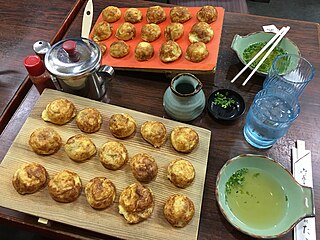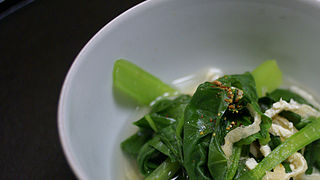
Sushi is a Japanese dish of prepared vinegared rice, usually with some sugar and salt, plus a variety of ingredients, such as vegetables, and any meat, but most commonly seafood. Styles of sushi and its presentation vary widely, but the one key ingredient is "sushi rice", also referred to as shari (しゃり), or sumeshi (酢飯).

Oden is a type of nabemono consisting of several ingredients such as boiled eggs, daikon or konjac, and processed fishcakes stewed in a light, soy-flavored dashi broth.

Nabemono, or simply nabe, is a variety of Japanese hot pot dishes, also known as one pot dishes and "things in a pot".

Onigiri, also known as omusubi (お結び), nigirimeshi (握り飯), or rice ball, is a Japanese food made from white rice formed into triangular or cylindrical shapes and often wrapped in nori. Traditionally, an onigiri is filled with pickled ume (umeboshi), salted salmon, katsuobushi, kombu, tarako, mentaiko, takanazuke or any other salty or sour ingredient as a natural preservative. Because it is easily portable and eaten by hand, onigiri has been used as portable food or bento from ancient times to the present day. Originally, it was used as a way to use and store left-over rice, but it later became a regular meal. Many Japanese convenience stores and supermarkets stock their onigiri with various fillings and flavors. It has become so mainstream that it is even served in izakayas and sit-down restaurants. There are even specialized shops which only sell onigiri to take out. Due to the popularity of this trend in Japan, onigiri has become a popular staple in Japanese restaurants worldwide.

Okonomiyaki is a Japanese teppanyaki, savory pancake dish consisting of wheat flour batter and other ingredients cooked on a teppan. Common additions include cabbage, meat, and seafood, and toppings include okonomiyaki sauce, aonori, katsuobushi, Japanese mayonnaise, and pickled ginger.

Donburi is a Japanese "rice-bowl dish" consisting of fish, meat, vegetables or other ingredients simmered together and served over rice. Donburi meals are usually served in oversized rice bowls which are also called donburi. If one needs to distinguish, the bowl is called donburi-bachi and the food is called donburi-mono.

An omelette is a dish made from eggs, fried with butter or oil in a frying pan. It is a common practice for an omelette to be folded around fillings such as chives, vegetables, mushrooms, meat, cheese, onions or some combination of the above. Whole eggs or egg whites are often beaten with a small amount of milk, cream, or water.

Akashiyaki (明石焼き) is a small round dumpling from the city of Akashi in Hyōgo Prefecture, Japan. The dumpling is made of an egg-rich batter and octopus dipped into dashi before eating. Modern style akashiyaki first started selling in the Taishō period by a yatai shopper Seitarō Mukai.

Sukiyaki is a Japanese dish that is prepared and served in the nabemono style.

Tsukune (つくね、捏、捏ね) is a Japanese chicken meatball most often cooked yakitori style and sometimes covered in a sweet soy or yakitori tare, which is often mistaken for teriyaki sauce.

Tamago kake gohan is a popular Japanese breakfast food consisting of cooked Japanese rice topped or mixed with raw egg and soy sauce.

Frittata is an egg-based Italian dish similar to an omelette or crustless quiche or scrambled eggs, enriched with additional ingredients such as meats, cheeses, or vegetables. The word frittata is Italian and roughly translates to 'fried'.

An egg sandwich is a sandwich with some kind of cooked egg filling. Fried eggs, scrambled eggs, omelette, sliced boiled eggs and egg salad are popular options. In the last case, it may be called an egg salad sandwich.

A soy egg is a type of egg in Chinese cuisine, Japanese cuisine, and Mauritian cuisine which is boiled, peeled, and then cooked in a mixture of soy sauce, sugar, water, and other optional herbs and spices. Other ingredients such as meat, vegetables and tofu can be cooked in the same red cooking method, resulting in dishes generally referred to as lou mei. Soy eggs can be made from chicken, duck, and quail eggs.

Japanese cuisine has a vast array of regional specialities known as kyōdo ryōri (郷土料理) in Japanese, many of them originating from dishes prepared using local ingredients and traditional recipes.

Tamagoyaki is a type of Japanese omelette made by rolling together several layers of fried beaten eggs. It is often prepared in a rectangular omelette pan called a makiyakinabe or tamagoyakiki. The word "tamago" means egg in Japanese, and the word "yaki" means to be cooked over direct heat.

Motoyaki is a style of cooking, involving baked food topped with a mayonnaise-based sauce and served in an oyster shell. It is typically available in Japanese restaurants on the Pacific coast of Canada. Examples of motoyaki dishes are oyster motoyaki and lobster motoyaki.

Norimaki (海苔巻) are various Japanese dishes wrapped with nori seaweed, most commonly a kind of sushi, makizushi (巻き寿司).




















